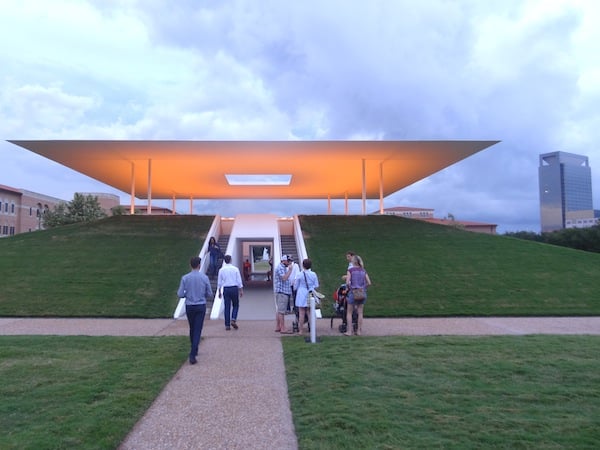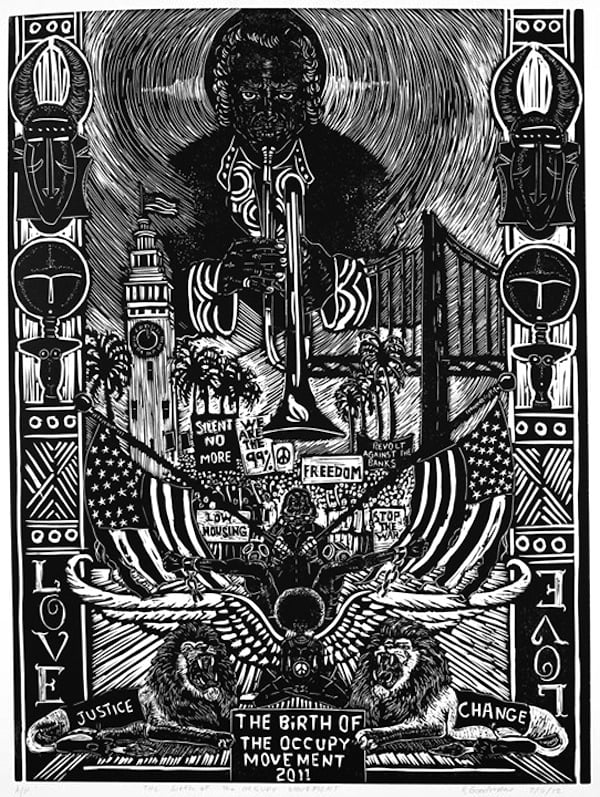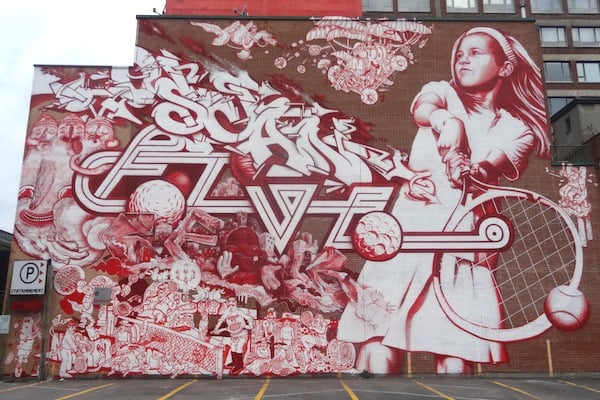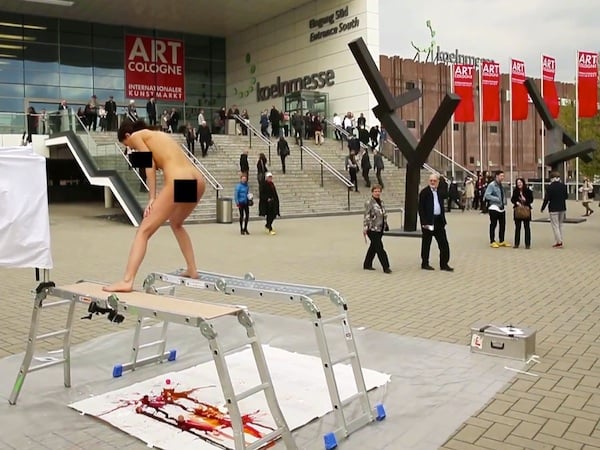Art World
The Essentials: Eggcellent Nude Performance Art, the Fate of Photobooks, and More Art News to Start Your Week
Plus Texan cities compete for cultural supremacy, and Annie Leibovitz on Miley Cyrus.

Plus Texan cities compete for cultural supremacy, and Annie Leibovitz on Miley Cyrus.

Benjamin Sutton


Ronnie Goodman, The Birth of Occupy Movement (2011).
Courtesy the artist, Hospitality House.
The Profile: Artists and athletes typically go through extensive training to become masters of their disciplines, so imagine how much work 53-year-old artist and runner Ronnie Goodman is going to have to put in to participate in this year’s San Francisco Marathon. Goodman is also homeless. The San Francisco Chronicle‘s Kevin Fagan profiles the artist-athlete, visiting the studio where he creates his powerful and intricate black-and-white prints, and shadowing him during his training regimen. “Ronnie is someone whose work should be in a museum, and I’m serious about that,” says Ian Vera, director of the Hospitality House art initiative. “His running is wonderful—that’s his self-care. . . . But his artwork? Amazing.”
The Feature: The field of photography has been blown wide open by the proliferation of digital image-making devices and technologies, but how has that technological revolution affected the inherently more old-school medium of the photobook? The Telegraph‘s Lucinda Everett takes a survey—on the occasion of Phaidon publishing The Photobook: A History, volume III—of the market for photobooks, from the dealers and auction houses hawking first editions of seminal books like Robert Frank‘s The Americans to self-published success stories like Christina de Middel’s The Afronauts. “For photographers, an ebook or even a digital representation on a site is not a substitute,” says Eileen Gittins, the founder and CEO of self-publishing company Blurb. “They want people to reflect and turn the page slowly. We even have Instagammers creating books, and when they see their work in print, that’s magic for them. It’s like they’ve arrived.”
The Extra Feature: The Financial Times jumps the gun a little trying to predict how the ongoing Ukrainian crisis will affect Russian collectors’ appetites during the upcoming spring auctions and in the art market more generally. We’ll have to wait for the May auctions in New York and the London sales in June and July, Henry Mance concludes, before any quantifiable effects can be measured.

James Turrell’s Twilight Epiphany skyspace on the Rice University campus in Houston.
Photo: Benjamin Sutton.
The Double Feature: Which Texan metropolis has usurped Austin’s place as the state’s coolest city? It depends whether you read Bloomberg’s survey of the maturing and ever-growing cultural and culinary scene in Houston, or W Magazine‘s chronicle of the arts scene in Dallas, both of which cite the competing mega-cities’ claims to have unseated the state’s über-hip capital as Texas’s coolest municipality. “We have such a multicultural influence,” Houstonian singer-songwriter Lyle Lovett tells Bloomberg. “You can see the world just walking down the street here.” W‘s Allyson Shiffman finds a similarly vibrant scene in Texas’s second biggest city: “Dallas has three key ingredients that make it an ideal place to cultivate an arts scene—space, money, and civic-minded patrons.”
The Interview: On the occasion of her new “Sumo” book from Taschen, photographer Annie Leibovitz chats with the Los Angeles Times‘s Steve Appleford about the new tome, her iconic photograph of John Lennon and Yoko Ono, and offers her thoughts on Miley Cyrus—whom she photographed in 2008 for Vanity Fair, sparking an enormous controversy. “When I met her you could tell she was on the verge,” Leibovitz says of Cyrus. “She was a girl becoming a woman. We took those pictures and I thought she looked so beautiful and having a little bit of an edge to her. She loved doing the pictures, and she was made to feel bad for doing them.”
The Restitution Feature: In a global survey spanning Sicily to Turkey to Peru, the New York Times looks at the charged business of restituting artifacts. Repatriation cases from recent years included in Rachel Donadio’s feature involve such major US institutions as the Metropolitan Museum, the Museum of Fine Arts, Boston, and the J. Paul Getty Trust. Getty president James B. Cuno comments: “It’s not the same with music, it’s not the same with film, it’s not the same with literature—but when it comes to physical objects, these things are kept as evidence of a proud past, as defined by the nation-state government.”

Gustave Caillebotte’s Paris Street; Rainy Day (1877), pre-restoration.
Art Institute of Chicago, via Wikimedia Commons.
The Behind-the-Scenes Feature: In a fascinating close look at the restoration of Gustave Caillebotte‘s Paris Street; Rainy Day (1877) at the Art Institute of Chicago—one including an interactive before-and-after illustration—the Wall Street Journal‘s Kyle MacMillan finds that the sky in the painting was originally a range of different colors, and not the familiar, uniform dull yellow, which was the result of a previous restorer’s touch-up. “We are all surprised,” says restorer Faye Wrubel. “Nobody anticipated that. We’ve accepted this painting in its present state for so long that everyone thought the yellow color was the atmosphere of the rainy day that Caillebotte intended.”
The Think Piece: Riffing on French economist Thomas Piketty’s already seminal book Capital in the Twenty-First Century—whose English translation hit bookshelves last month—wherein he concludes free-market capitalism will result in greater wealth inequality as the rich become richer, Scott Reyburn in a New York Times article applies similar logic to the art market. Reyburn finds the art market increasingly dominated by a few exceptionally wealthy financiers buying up eight- and nine-figure artworks. Conclusion? The polarization of the haves and the have-nots is indeed playing out in the field of art. “The art market has become an excuse for banking in public,” comments London-based dealer Ivor Braka. “People are displaying wealth in the most ostentatious way possible. It’s luxury goods shopping gone wild.”
The Opinion Piece: Philip Johnston is tired of blockbuster exhibitions, so much so that he claims in the Telegraph that he’d rather skip the three biggest currently in London—the Henri Matisse cut-outs at Tate Modern, the Veronese show at the National Gallery, and the British Museum’s Vikings extravaganza—to get a closer, more tranquil look at comparable works in permanent collections of London institutions. “I would much rather spend some time largely alone with the Anglo-Saxon Sutton Hoo treasure,” Johnston writes, “than fight my way through the hordes like a Berserker for a glimpse of a reconstructed longboat.”
The Working Artists Story: Much has been made of the “Goodbye to All That” literary sub-genre. This is the one in which creative types bid adieu to New York City and the innumerable challenges it presents to artists who just want the time and space to make their art. But for those who choose to stay, the example of Catherine Lacey is an instructive one. She and her six housemates launched a cooperative bed-and-breakfast in their apartment in 2010, with the idea that if the work were properly divided up they would all have more time to devote to their creative pursuits. “Many artists work service jobs like these in order to make ends meet, but they also happen to be particularly well suited for the cooperative structure,” Lacey writes in the New York Times. “In addition to workers making a higher wage and having greater control of their schedule, the client’s or guest’s experience is often better when workers are more deeply invested.”

En Masse mural in Montreal.
Photo: Benjamin Sutton.
The List: Planning your summer vacation? Perhaps you should look into visiting one of the places on the Huffington Post’s list of the 26 best cities in the world for street art, which includes some obvious destinations like Berlin, São Paulo, New York, and Montreal, as well as surprising ones, like the Chilean capital of Santiago.
The Hobby: Dog photographer William Wegman has become something of a connoisseur of Elizabethan music, though his expertise has very practical origins. “My love of Renaissance music began out of necessity,” Wegman recounts in the Wall Street Journal. “During the 1980s, I lived in New York’s East Village, about a block from the Pyramid Club. Most nights, the club’s thumping music invaded my apartment and drove me crazy. Only recordings with a cello or viol—an early-music stringed instrument—could mask it.”
The Job Opening: Index, the Swedish Contemporary Art Foundation based in central Stockholm that is celebrating its 40th anniversary this year, is looking for a director. Applications are due by May 11.
The Eye Candy: Long before the launch of the rogue taxidermy biennial, Englishman Walter Potter was creating cute, creepy, and surreal dioramas in which taxidermic animals acted out everyday scenes from Victorian life, at tea services and weddings to gambling parlors and funerals. The Telegraph has assembled an irresistible slideshow of these and other Potter masterpieces.

Still from Milo Moiré performance The “PlopEgg” Painting Performance #1 (2014).
Via YouTube.
The WTF: Earlier this month during Art Cologne, in what we can only assume was an attempt at kickstarting Easter season in the art world, the Swiss performance artist Milo Moiré set up a couple of scaffolds over a canvas in the square outside the messe, removed all her clothes, and created a painting by squeezing paint-filled eggs out of her vagina, Libération reports. A video of the performance art stunt, titled The “PlopEgg” Painting Performance #1 (2014), is available for your viewing on YouTube.
The Extra-Curricular: Though the implications for the practice of using drones to make paintings remains unclear, the Spanish government’s move to ban all commercial uses of drone aircraft could have serious implications for the Andalusian film industry, which is one of the few thriving sectors in the region with Europe’s highest unemployment rate, reports Quartz. “Film producers use drones a lot,” says Andalusia Film Commission president Piluca Querol, “especially in pre-production to get things ready, prepare shots, and look for possible camera positions. . . . Of course [drone images] promote Spain abroad, in our case as a great place to film movies.”